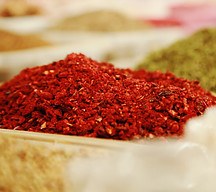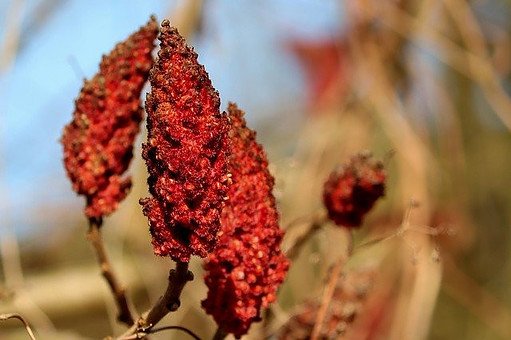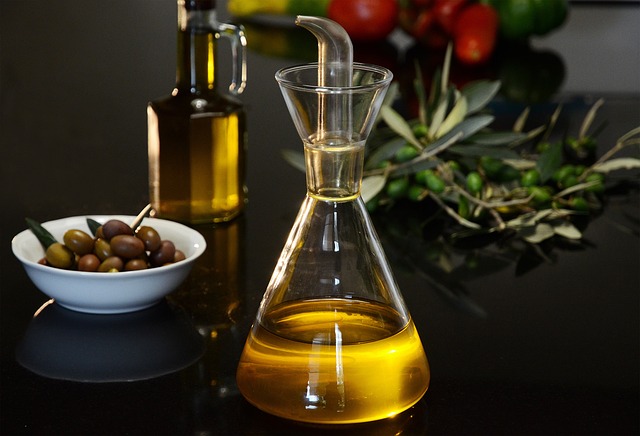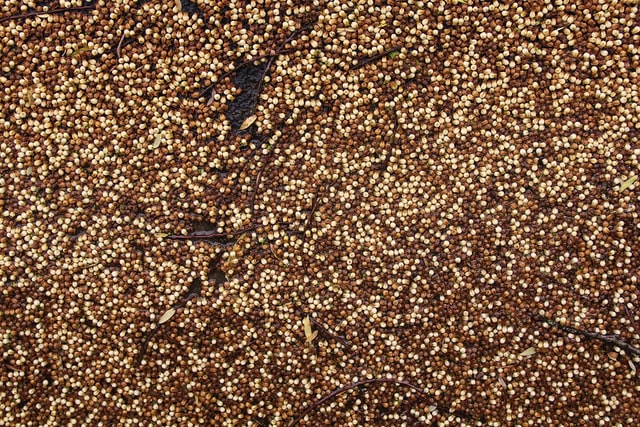What is Sumac Spice – Flavour! Flavour! Flavour!
All You Wanted To Know About Sumac, And What To Use Sumac For?
If you enjoy Middle Eastern cuisine, you’ve probably already enjoyed sumac’s tangy, citrusy personality. The spice’s bright wine color is also a hard-to-miss telltale.
Sumac is having a moment. Although people have used it for thousands of years, western cuisines are finding in the spice’s unique color and taste profile an opportunity to embellish dishes while infusing them with pleasant acidity.
What is sumac spice, and what to use sumac for, are still two topics clouded in mystery, but today we’re unraveling them and dissect sumac once and for all.
What Is Sumac Spice?

Sumac is a Middle Eastern spice. The spice’s uncommon name derives from the Arabic summāq meaning “red,” and it’s obtained from a few of 35 species of flowering shrubs of the Rhus species, being the most common the Rhus Coriaria or elm-leaved sumac. The plants themselves are subtropical in origin and can be found in East Asia, Africa and North America.
Sumac is the fruit of the rhus shrubs, seen from a distance for their bright red color. These small drupes, clustered at the tip of the branches, are often harvested manually.
The red spice is not only a creative ingredient for both traditional and modern dishes, but it’s also healthy. Ancient Greeks, Romans and Persian cultures knew that sumac was not only tasty and good-looking but also beneficial.
What To Use Sumac For?
In the past, before citrus fruits dominated the acidic flavors in our food, people used sumac to add a zip to dishes. As you know, acidity elevates the flavors and balances the fat in food.
Sprinkling sumac over yogurt, hummus, grilled fish or veggies are natural ways of adding the healthy spice to your diet, and sumac’s burgundy color will enhance your food presentation too.
Using sumac in the kitchen is as easy as adding a teaspoon to salads, seafood, stews and soups as if you were adding a drizzle of lime juice. Sumac berries are acidic, and the tanginess translates to the powdered spice.
Sumac’s Health Benefits
Sumac regulates blood sugar –Consuming sumac consistently can prevent insulin resistance by lowering blood sugar levels, a benefit people with diabetes or diabetic family history will appreciate.
Sumac might reduce cholesterol – Some studies suggest sumac can help reduce triglyceride and blood cholesterol levels, mainly low-density or bad cholesterol, thanks to the berries’ polyphenols and flavonoids.
Sumac may strengthen your bones – Certain compounds in sumac might enhance bone metabolism, strengthening the bones and preventing their premature de-calcification. We still need more scientific studies to confirm these claims, but the results look promising so far.
Sumac has lots of antioxidants – Sumac is also an important source for antioxidants, which can bind with harmful free radicals floating in your bloodstream, responsible for tissue degeneration and cell damage. Oxidation leads to many modern maladies from heart disease to premature aging.

Compounds in sumac could relieve muscle pain – Antioxidants in sumac could reduce chronic inflammation, reducing joint pain, soreness, and easing muscle pain after work out. Sumac is now part of many nutritional supplements and has been embraced by the health-conscious community.
Nutritional Value in Sumac
Two teaspoons of sumac add 15 calories to your diet, 6% of your sodium daily needs and 3% of potassium. In addition, the same amount of sumac adds 32% of your daily intake for Vitamin A, and 5.2% of iron.
Interestingly enough, despite sumac’s acidic taste, the berries only have trace amounts of vitamin C. They get their acidity form malic acid.
Fun Facts About Sumac
Here are a four interesting facts about your new favorite all-natural flavoring agent, sumac.
Although herbivores don’t eat sumac for the shrub’s thorny nature, a wide variety of birds, attracted to the berry’s color, spread the plant’s seeds across the land.
Native Americans appear to have enjoyed smoking sumac fruit wrapped in leaves. Perhaps they knew something we don’t.
Sumac has so many polyphenols; it is used for tanning leather, mostly in Morocco, as part of centuries-old artisan techniques.
Some sumac related plants are poisonous, so don’t eat wild sumac unless you know the difference between the dangerous and the safe varieties.
Now You Know All About Sumac
Now that you know how to cook with sumac, where it comes from, and the health benefits it might bring, it’s time to get yourself some brightly red powder and get cooking. You can shop for Sumac here
**High Quality Pure Sumac, No Salt, No Irradiation can be bought here**
Share this information with your friends and family and invite them for dinner; see if they can distinguish what gives such a tangy taste to your meals!
Highly Rated Social posts – recipes using supac spiceal Posts
سماق پلو🥘
arame.shkadee
.
🔴مواد لازم برای پنج نفر:
۵ پیمانه برنج
۶۰۰ گرم گوشت چرخ کرده
۱ عدد پیاز متوسط
۳ قاشق غذاخوری سماق
۴ قاشق غذاخوری زعفران دم کرده
۵ عدد گوجه
نمک، فلفل، زردچوبه به میزان دلخواه
.
.
.
.
🎥Rural_Cuisine
.
.
🔴Ingredients for 5 servings:
5 cups rice
600 gr Ground meat
1 Medium Onion
3 Tablespoons Sumac
4 Tablespoons Brewed Saffron
5 Tomatoes
Salt, Black Pepper Powder, Turmeric Powder as needed
.
.
#sumacpilaf #sumac #sumacrice #rice #ruralcuisine #rural_cuisine #villagelife #countrylife #asmrcooking #persiancuisine #gilan #mazandaran #iran
#سماق_پلو #سماقپلو #سماق #پلو_مخلوط #غذای_شمالی #غذای_ایرانی #غذای_مجلسی #آشپزی_روستایی #زندگی_روستایی #گیلان #مازندران #ایران
سماق پلو🥘
dastpokht_ironiii
dastpokht_ironiii
.
🔴مواد لازم برای پنج نفر:
۵ پیمانه برنج
۶۰۰ گرم گوشت چرخ کرده
۱ عدد پیاز متوسط
۳ قاشق غذاخوری سماق
۴ قاشق غذاخوری زعفران دم کرده
۵ عدد گوجه
نمک، فلفل، زردچوبه به میزان دلخواه
.
.
.
.
🎥Rural_Cuisine
.
.
🔴Ingredients for 5 servings:
5 cups rice
600 gr Ground meat
1 Medium Onion
3 Tablespoons Sumac
4 Tablespoons Brewed Saffron
5 Tomatoes
Salt, Black Pepper Powder, Turmeric Powder as needed
.
.
#sumacpilaf #sumac #sumacrice #rice #ruralcuisine #rural_cuisine #villagelife #countrylife #asmrcooking #persiancuisine #gilan #mazandaran #iran
#سماق_پلو #سماقپلو #سماق #پلو_مخلوط #غذای_شمالی #غذای_ایرانی #غذای_مجلسی #آشپزی_روستایی #زندگی_روستایی #گیلان #مازندران #ایران
A dish inspired by South Indian curd rice, my recent trip to Jordan and ingredients I brought back from the region. The rice is mixed with strained Greek yogurt, imitating the delicious labneh I had every morning, and drizzled with sizzling olive oil stirred with cumin seeds, sumac and dried chili. It’s topped with mixed za’atar spiced nuts, golden raisins and, a couple bites in, some halved green olives.
I do plan on finally sharing more about my trip this week. The specter of the war obviously hung heavily over our travels even though, as tourists, we were insulated from tension or conflict. My recounting will remain mostly food-focused but I’m certainly praying for aid, for a cease-fire and for healing.
Rice -
Cooked basmati rice • salted and strained Greek yogurt (labneh-ish) • salt
Spiced oil -
Heated olive oil • cumin seeds • sumac • dried chili • salt
Toppings -
Za’atar spiced mixed nuts • golden raisins • halved bigpicturefoods green Amfissa pitted olives
•
•
•
#curdrice #yogurtrice #ricebowl #sumac #zaatar #chili #mixednuts #spicemarket #olives #goldenraisins
Sources:
- https://en.wikipedia.org/wiki/Sumac
- https://www.cookinglight.com/nutrition-101/how-to-use-sumac
- https://www.masterclass.com/articles/what-is-sumac-learn-how-to-use-sumac-with-tips-and-8-sumac-recipes
- https://www.bbcgoodfood.com/glossary/sumac
- https://stepfeed.com/12-facts-to-know-about-sumac-before-sprinkling-it-on-fattoush-1559
- https://www.nutritionix.com/food/sumac
- draxe.com/nutrition/sumac-spice/






Hi Lea again here I want to congratulate you on the choice of topic. I have never heard of this spice. It is very interesting to know that it lowers both insulin and cholesterol.Anyway, you made me interested in this topic, and I’m definitely going to look for it in the Sumac home store and also try some recipes. Do you have any recipes to suggest?
Great thanks. Please check above for recipes. Click load more and you should be able to see recipes
Hello there awesome article you have here, it really dragged my attention I just could not ignore it. I really didn’t know anything about sumac spice but this has really educated me alot on sumac spice and it really has some great health benefits am sure going to tell my friends and family about this and am also going to try it out after now thanks for sharing this with me
It is my first time to hear about this kind of spice. But it seems like it’s a good spice in food and has benefits in the body or health. Thank you so much for your excellent site.
Great to hear Johane
This has been an interesting discovery for me. I would like to try sumac on my salads. I also love seafood and would like to try it with it too.
I like good tasty meals but if they’re healthy, it’s even better. And sumac, having a lot of antioxidants and helping our bones makes it impossible not to try. Thanks!
great to hear
hello, thanks alot for sharing such an amazing post with us all, i was actually doing some research online when i saw your article on Sumac Spice, i really want to commend your effort in bringing such an amazing site, i saw some reviews on Sumac Spice, that its health benefits were amazing, i never really thought some thing like this has that much health benefits, your article really is an eye opener, thanks alot for the info.
I love having those great spice in my kitchen and also making sure that they are not just an ordinary spice but that they all have some very good and also important health benefits all round. I am very eager to start using this sumac that I have learnt about here on your website. It seems really cool but I want to know how it is in relation to tumeric.